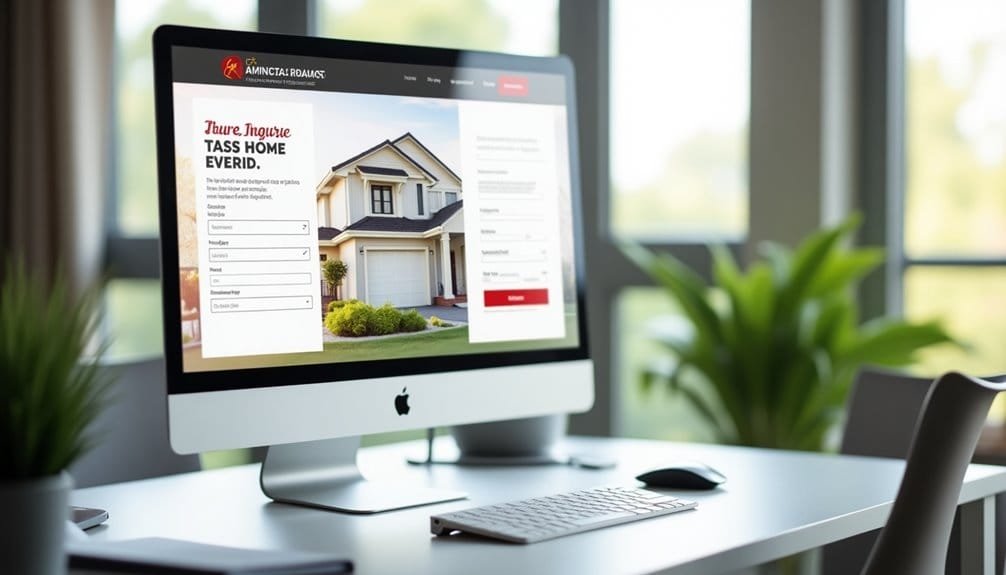Creating effective real estate lead capture forms on your website involves strategic design, placement, and enticing offers. Opt for a simplistic design and single-column layout to enhance usability and engagement. Position forms prominently, such as in the hero section or embedded within content, balancing visibility with user exploration. Use clear and concise offers, like market reports or exclusive listings, to entice users. For seamless integration, leverage secure form builders and connect them with CRM platforms for centralized management. Remember, continuous A/B testing will refine placements, improving conversion rates. Explore these strategies further to maximize your lead generation potential.
Key Takeaways
- Use a simplistic, single-column design to reduce friction and improve user engagement.
- Position forms strategically, such as in the hero section or within content every 350 words, for optimal visibility.
- Offer valuable incentives like e-books or exclusive listings to encourage form completion.
- Integrate CRM and automation tools for seamless lead management and communication.
- Conduct A/B testing to refine form placement and design for higher conversion rates.
Key Features of Lead Forms

When designing effective real estate lead capture forms, it’s vital to focus on form structure and design that streamline user interaction and boost conversion rates. You should aim for a simplistic design, keeping forms clean and minimal to reduce friction for potential leads. Begin with easy-to-answer questions to prioritize early engagement, drawing users in without overwhelming them. Implement logic jumps to guide visitors smoothly to the next step based on their responses, maintaining a natural flow. Customizable templates are essential, allowing you to adjust themes, questions, and layouts to suit your needs. Incorporating visual elements like images and graphics can enhance the user experience, making the form more inviting. A user-friendly interface can significantly improve the user experience (UX), increasing the likelihood of potential buyers completing the form. As you progress, gradually increase question complexity to gather more detailed information without deterring users. Realtors often face challenges in lead qualification, where manual processes can be inefficient, so interactive quizzes and personalized surveys can create a fun, engaging experience, tailoring follow-up messages based on collected data. Utilizing lead management tools can further streamline the process of capturing and nurturing leads effectively. Utilize welcome screens to provide pauses, making the form feel conversational. These strategies guarantee your lead capture forms not only attract but also retain user interest, ultimately improving your conversion rates in the competitive real estate market.
Optimal Form Placement
Although the design of your real estate lead capture form is vital, its placement can make or break your conversion rates. Positioning your forms strategically can greatly enhance engagement and lead generation. Consider placing forms in the hero section for maximum visibility, though this might deter visitors from exploring the rest of your page. Embedding forms within content every 350 words is a balanced approach that integrates lead capture naturally. Popups triggered by user actions like scroll depth can capture attention, but be cautious—they can also annoy visitors. Lead capture forms convert website visitors into potential customers, which highlights their significance in the lead generation process.
Incorporating forms at the bottom of content can yield higher quality leads, as engaged visitors are more likely to reach this point. High-quality forms lead to better engagement, necessitating UX-backed strategies to improve interaction and conversion rates. A/B testing different placements is important, allowing you to find the most effective strategy. Ensure that your form placements align with effective communication strategies, guiding potential leads through a seamless experience. Make sure to align form placement with the user journey, ensuring each form fits naturally into your content flow. This balance is key, as you don’t want to overwhelm potential leads but rather guide them smoothly through your site.
Design and Layout Tips

To create an effective real estate lead capture form, focus on design and layout principles that prioritize user experience. Start by opting for single-column layouts, which offer a clean and straightforward path, reducing cognitive workload and enhancing usability. Visual appeal is essential; use adequate white space and clear labels to make your forms easy to scan and fill out. Pre-made templates can be a lifesaver, saving you time while ensuring design consistency. These templates, often available through form builders, cater to various industries, including real estate. An important aspect of high-converting forms is to provide specific value, such as offering downloadable guides or market insights, to entice users to complete the form. For instance, incorporating email marketing software can streamline follow-ups and nurture leads effectively. Testing different form types, such as passive vs. aggressive, can optimize lead acquisition and improve conversion rates. Branding consistency across your forms is important. Align elements like typography, graphics, and colors with your website’s brand to maintain a cohesive and professional look. Implement conditional logic to make forms dynamic, hiding irrelevant fields based on user input, thereby reducing form fatigue and personalizing the experience.
Integration and Automation
Imagine streamlining your real estate lead capture process with seamless integration and automation. Leveraging key tools like Zapier, Webhooks, and Google Cloud Integration can transform how you manage leads. With Zapier, you effortlessly connect various apps, automating tasks and guaranteeing smooth lead capture workflows. Webhooks play an essential role in integrating your forms with other online marketing tools, enhancing their functionality and reach. Google Cloud Integration elevates your forms by providing address autocomplete, making it easier for prospects to fill out forms accurately. Using secure form builders can reduce the risk of data breaches, ensuring that your lead capture process is not only efficient but also safe. Advanced targeting allows customization of who sees your messages, further improving the effectiveness of your lead capture efforts. Additionally, implementing a CRM platform can centralize lead management and streamline communication for optimal results.
Consider these automated strategies for enhanced efficiency:
- Automated Lead Routing: Instantly direct leads to the right people or systems.
- Email Verification: Confirm email addresses to verify you’re capturing accurate information.
- Conditional Logic: Tailor form fields based on user selections for a personalized experience.
- Lead Qualification: Assess lead quality before submission to save time and resources.
- A/B Testing: Compare different form versions to see which performs best.
CRM integration is another pivotal aspect, guaranteeing seamless lead data transfer and management. Multichannel integration through tools like Zapier supports connections with email lists, expanding your marketing capabilities. Incorporating these elements can greatly enhance your lead capture strategy.
Incentives and Offers

Releasing the potential of your real estate lead generation through strategic incentives and offers can greatly boost engagement. By offering valuable content like e-books, market reports, and exclusive property listings, you entice visitors to share their contact information. Providing insights into local market trends or offering free home valuations can be particularly appealing to potential sellers. Including RPR reports such as Property, Market Activity, or Neighborhood Reports adds further value, making certain visitors find your offers compelling and relevant. In the evolving landscape of real estate, the use of AI-powered lead nurturing tools is on the rise, further enhancing the effectiveness of these incentives. Furthermore, using email marketing strategies can significantly improve your outreach and engagement efforts.
Strategically placing these incentives on your website is essential. High-traffic pages like property listings and blog posts are ideal spots, and using pop-ups for targeted offers can capture attention effectively. Positioning incentives on landing pages increases conversion rates, while hero sections can highlight offers without overwhelming visitors. Make certain these offers are clear and concise to avoid confusion, using single-column layouts for a smooth user experience. A user-friendly interface enhances visitor engagement and conversion rates by facilitating easy navigation, which is crucial for the success of your lead generation efforts.
Diversify your incentives by including gated content or downloadable lead magnets like lists of preferred appraisers or home stagers. Tailor buyer and seller-specific landing pages with relevant offers. Testing different incentives will help you determine which strategies resonate best with your audience, optimizing your lead capture efforts.
Recommended Form Builders
When it comes to capturing leads effectively, choosing the right form builder is essential. You need a tool that aligns with your needs and makes the form creation process seamless. Here’s a rundown of some popular form builders to evaluate:
- Gravity Forms: Perfect for WordPress users, it offers conditional logic for personalized forms and a one-time cost of $39, making it a solid investment.
- Ninja Forms: Known for its simple drag-and-drop interface, it caters to both free and paid users, ideal for those with a WordPress site who want ease of use.
- Google Forms: A free and reliable option, it integrates well with other Google services, suitable for straightforward form needs.
- Wufoo: Provides both free and paid options with an intuitive form designer, offering embeddable forms for easy inclusion on any site.
- Form Tools: An open-source tool that runs on PHP, it’s best for tech-savvy users looking for extensive customization and integration options.
Each of these builders comes with distinct features like conditional logic, pre-designed templates, and CRM integration. Reflect on your budget, technical skills, and specific requirements to select the best fit for your real estate website.
Analyzing and Improving Performance

Effective lead capture relies heavily on analyzing and improving the performance of your real estate forms. Understanding form placement can greatly influence conversion rates. Forms in the hero section grab attention but may disrupt content engagement. Embedding forms within content every 350 words can emphasize their value without intrusion. Pop-ups triggered by actions like scrolling or exit intent are excellent for encouraging opt-ins, while forms at the bottom of content effectively capture already engaged visitors. Employ A/B testing to determine ideal form placement, ensuring you’re maximizing your lead capture potential.
Improving form design is equally important. Opt for single-column layouts to enhance user experience and increase completion rates. Clear labels, adequate white space, and concise fields (3-5) keep forms user-friendly. Multi-step forms make the process less intimidating, while pre-made templates simplify creation. Enhancing user experience involves using autofill options, progress indicators, and ensuring mobile optimization. A conversational tone personalizes interactions, and a privacy policy reassures visitors about their data security. Additionally, consider utilizing automation tools to streamline the form submission process and improve response times.
- Prepare for Loan Maturities and Refinancing Waves as a Real Estate AgentIn mastering loan maturities and refinancing waves, uncover strategies every real estate agent needs to empower clients during pivotal financial transitions.
Frequently Asked Questions
How Can Lead Capture Forms Impact SEO for Real Estate Websites?
Lead capture forms boost SEO for real estate sites by enhancing user engagement and reducing bounce rates, which search engines favor. You should optimize these forms with structured data and relevant keywords to improve visibility. Make certain they load quickly and are mobile-friendly, as search engines prioritize responsive design. Integrate them with high-quality content and update regularly to keep your site indexed. SSL encryption and clear page structure also enhance security and crawlability.
Recent Posts
What Legal Considerations Are There for Collecting User Data With Lead Forms?
Imagine data collection as a delicate dance—you’ve got to lead with consent and transparency. Always guarantee compliance with the FCC’s 1:1 consent law by using consent tags. Store data securely, clearly communicate usage, and include an opt-in checkbox for emails. Verify leads to avoid penalties. Maintain clear privacy policies, obtain explicit consent, and limit data collection to essentials. Allow users to access, correct, or delete their data, guaranteeing compliance with regulations.
How Can I Ensure Lead Form Security Against Data Breaches?
To guarantee lead form security against data breaches, you should implement secure form builders like Gravity Forms or Ninja Forms, which offer SSL encryption. Regularly update these plugins to prevent vulnerabilities. Utilize Google reCAPTCHA to block spam, and enable OTP phone and email verification for authenticity. Integrate forms with secure platforms like Google Drive for data storage. By following these measures, you’ll enhance security and protect sensitive information effectively.
What Are the Best Practices for A/B Testing Lead Capture Forms?
When A/B testing lead capture forms, you should start by setting clear goals like testing form placement or the number of fields. Choose specific elements to alter, such as layout or CTAs. Identify your target audience and establish metrics for success, like conversion rates. Run tests simultaneously, ensuring equal traffic distribution. Monitor results in real-time, analyze outcomes for statistical significance, and apply the winning variations. Continuously refine your forms based on insights gained.
How Can I Personalize Lead Capture Forms for Different Property Types?
When personalizing lead capture forms for different property types, focus on key details relevant to each category. For residential properties, ask about the number of bedrooms, bathrooms, and preferred amenities. Commercial properties require fields for business type and office space needs. Condominiums benefit from questions on unit size and building amenities. Luxury properties should emphasize high-end features and customization options. Tailor questions to match the unique preferences and requirements of each property type.
Bottom Line
In crafting effective real estate lead capture forms, remember that simplicity and strategic placement can greatly enhance engagement. Consider a hypothetical realty firm that increased leads by 30% simply by placing a concise form on their homepage, offering a free market analysis. By integrating automation tools and offering compelling incentives, you create a seamless user experience that encourages action. Continuously analyze performance metrics and adjust strategies to guarantee your forms are always working to their full potential, capturing valuable leads efficiently.









